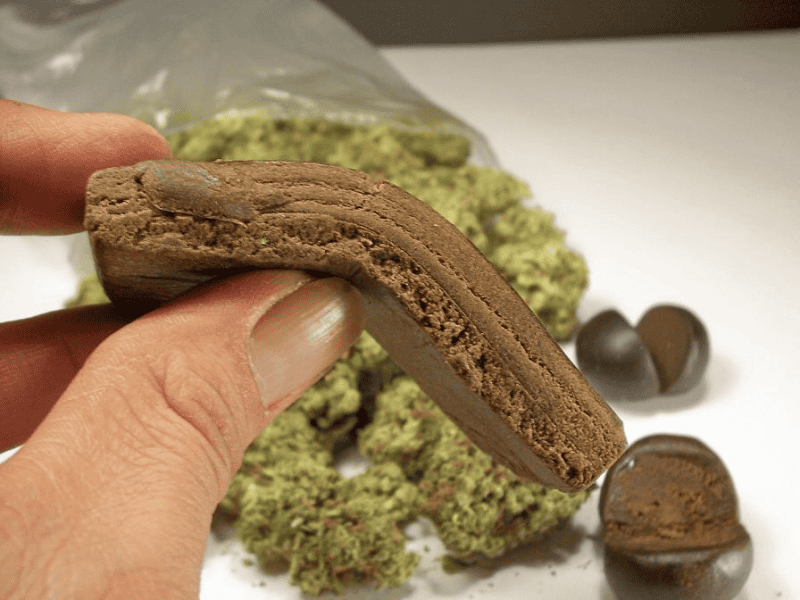All orders will now ship via Canada Post. Dismiss
Skip to contentShare

Hash, which is short for hashish, is a potent cannabis product derived from the plant’s resin. The cannabis plant can be classified as Cannabis sativa or Cannabis indica, each with its own unique properties. The psychoactive and medicinal effects of cannabis are caused by the high concentration of cannabinoids found in this resin, specifically tetrahydrocannabinol (THC) and cannabidiol (CBD). Experienced users looking for a stronger experience frequently choose hashish because it is usually more potent than traditional cannabis flower and is considered one of the many marijuana concentrates available. Thinking of switching up your cannabis regimen? Let’s review the uses, formats and effects of hash before adding it to your stash.
Key Takeaways

Hashish, commonly referred to as hash, is one of many types of cannabis concentrates available. It is a concentrated form of cannabis made from the resin of the cannabis plant, a sticky, sap-like substance produced by glandular trichomes on the flowers and leaves. This resin contains high concentrations of cannabinoids like THC, responsible for cannabis’ psychoactive effects, as well as CBD, and terpenes that contribute to the plant’s aroma and effects. Hash is typically produced by gathering the trichomes—tiny, hair-like structures on the cannabis plant that house the active ingredients. These trichomes can be processed in a variety of ways, such as compressing and drying the resin to produce hashes with distinct properties. Marijuana extracts, which include various forms of concentrates, are becoming increasingly popular due to their high THC content and the changing legal landscape. Depending on the extraction technique and the quality of the raw plant material, the final product may differ in form, such as small blocks, balls, hash oil, rosin, and powders; color; texture; and potency. These products can be consumed in different ways, such as smoking, vaporizing, or ingesting.
Cannabis concentrates, including hashish, can have up to four times higher THC content than traditional cannabis flower, ranging from 40 to 80%. Thus, it is commonly used for both recreational and medicinal purposes, offering users a more intense experience. Hash provides heightened sensory perception and can lead to altered perception, increased appetite, and psychological effects. As a potent form of cannabis, it is essential to consider the potential health effects and risks associated with its use, including anxiety, depression, and increased heart rate. Hash is a popular choice among those seeking a high concentration of active ingredients in their cannabis products.
Hashish, often referred to as hash, traces its origins back to the Middle East and Central Asia, with a history that spans several centuries. Historical records suggest that hashish was utilized for both recreational and medicinal purposes in Persia as early as the 12th century. The term “hashish” itself is derived from the Arabic word “hash,” meaning “grass.”
Over time, hash became increasingly popular across various cultures, particularly in regions like Morocco, Afghanistan, and India. By the 20th century, as cannabis culture expanded, hash gained recognition in Western countries. Its popularity surged during the 1960s and 1970s counterculture movements, boosting its availability in North America and Europe. While traditional hash remained prevalent, solvent-based concentrates like butane hash oil (BHO) did not emerge until the late 20th century, gaining popularity in the 1990s and early 2000s as extraction techniques advanced. Despite evolving production methods and changing legal landscapes, hashish remains a staple in the cannabis community today.

Hash is available in various forms, each distinguished by its unique characteristics and production methods.
Traditional Hashish
Traditionally, hash is crafted by hand, involving the meticulous collection of resin from live cannabis plants. This process includes techniques like rubbing and compressing the resin into small cakes or balls. This type of hash is known for its potent aroma and smooth texture. Regions like Afghanistan and India, where artisans have refined their skills over generations, are well-known for this method.
Bubble Hash
Another popular method is bubble hash, also known as ice water extraction. This technique involves agitating cannabis plant material in ice water to separate the trichomes from the plant matter. The mixture is then filtered through a series of mesh bags with varying micron sizes, allowing only the resin glands to pass through. The collected trichomes are dried and compressed to form a solid product. This method is favored for producing a cleaner, high-quality hash that retains its potent effects and rich flavor profile, as it contains more terpenes and cannabinoids. The color of bubble hash can range from light blonde to dark brown, depending on the quality of the raw material and extraction method.
Butane Hash Oil
Alternatively, there are solvent-based extracts like “hash oil produced” by using solvents such as ethanol or butane to extract cannabinoids from plant material. While this process can yield extremely potent products, it requires careful handling due to safety concerns related to flammable solvents. Hash oil can have a significantly higher THC content than other cannabis products, sometimes reaching up to 99%.
One well-known type of hash oil is honey oil, named for its golden, viscous appearance. Like other cannabis concentrates, honey oil is highly potent and is commonly consumed through vaping, dabbing, or adding to joints for an extra kick. Its purity and strength make it a favorite among experienced users seeking a refined cannabis experience.
Another increasingly popular hash product is rosin, a solventless concentrate made by applying heat and pressure to cannabis flower or hash. Many cannabis enthusiasts prefer rosin because it retains high terpene content, providing enhanced flavor and aroma. Since rosin production does not require harmful solvents, it is considered a cleaner and safer alternative for consumers looking for a natural cannabis extract.
Today, hashish remains a popular choice for both recreational and medicinal users, especially in countries like Canada, where its use is legalized and its benefits are recognized.
Hash primarily influences the brain by interacting with the endocannabinoid system, which is essential for regulating mood, memory, perception, and cognition. The primary psychoactive component in hash, THC, binds to CB1 receptors in the brain, especially in regions like the hippocampus, cerebral cortex, and basal ganglia. This interaction modifies neurotransmitter release, resulting in effects such as heightened sensory perception, altered perception, euphoria, and profound relaxation. Additionally, hash can elevate dopamine levels, enhancing feelings of pleasure and reward. Many users also find that hash boosts creativity and eases anxiety or stress. Given its concentrated nature, it’s crucial for users to start with a low dose, as even small amounts can produce powerful effects.
Hashish is renowned for its medicinal benefits, including relief from chronic pain, insomnia, nausea reduction, and anxiety alleviation. The legal landscape surrounding medical marijuana is evolving, with various states and countries updating their legislation. Some users also report better sleep quality and an increased appetite.
However, it’s important to recognize that hash can also have adverse effects, such as increased heart rate, anxiety, paranoia, distorted perception, challenges in problem-solving, and short-term memory loss, particularly when consumed in large amounts.
Long-term use has been linked to changes in brain structure and function, especially in areas related to memory and decision-making.
Its versatility allows hash to be used in various ways, including vaporization, edibles, tinctures, and smoking in a pipe or joint. While hash can offer therapeutic benefits and enjoyable experiences, it’s important to be aware of the associated risks.

While hashish or hash oil can be a safe and effective way to consume cannabis, it’s important to be aware of certain risks and take precautions to minimize them. Here are some key safety tips:
By adhering to these safety guidelines, individuals can enjoy the advantages of hashish and hash oil while reducing potential hazards.
Hashish remains one of the most potent and historically significant cannabis concentrates, cherished for its recreational and medicinal properties. From its origins in the Middle East and Central Asia to its widespread use in modern cannabis culture, hash has evolved through various production methods, offering a range of textures, flavors, and potencies. Whether in traditional hand-pressed forms, solvent-free extracts like bubble hash, or more refined products like hash oil, each type provides a unique experience tailored to different preferences and needs.
As with any cannabis product, responsible use is essential. Due to its high THC concentration, hash can produce intense effects, making it crucial for new users to start with small doses and gradually increase as needed. The potential therapeutic benefits, such as pain relief, anxiety reduction, and improved sleep, make hash an appealing option for medical cannabis users. However, it is equally important to consider the risks, including impaired coordination, heightened anxiety, and potential lung health concerns from smoking.
By sourcing hash from licensed dispensaries, following proper dosage guidelines, and being mindful of safe consumption methods, users can minimize risks while maximizing its benefits. As cannabis legalization continues to expand, the availability of regulated, high-quality hash products ensures safer access for consumers. Whether for relaxation, therapeutic relief, or cultural appreciation, hash remains a versatile and enduring element of the cannabis experience.